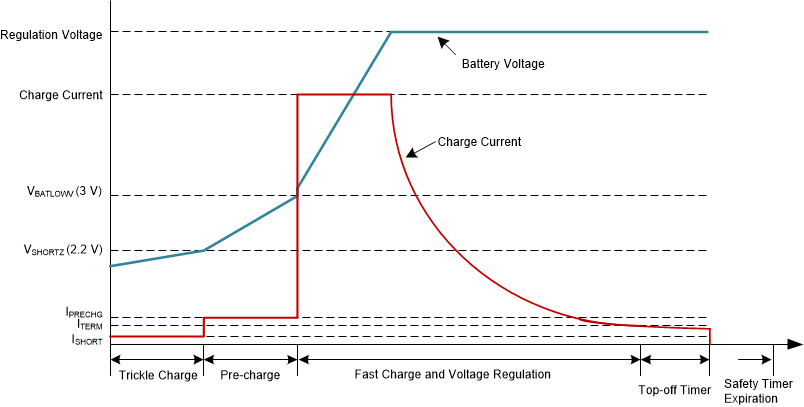JAJSJS8B October 2020 – July 2024 BQ25618E , BQ25619E
PRODUCTION DATA
- 1
- 1 特長
- 2 アプリケーション
- 3 概要
- 4 概要 (続き)
- 5 Device Comparison Table
- 6 Pin Configuration and Functions
- 7 Specifications
-
8 Detailed Description
- 8.1 Overview
- 8.2 Functional Block Diagram
- 8.3
Feature Description
- 8.3.1 Power-On-Reset (POR)
- 8.3.2 Device Power Up From Battery Without Input Source
- 8.3.3 Power Up From Input Source
- 8.3.4 Power Path Management
- 8.3.5 Battery Charging Management
- 8.3.6 Ship Mode and QON Pin
- 8.3.7 Status Outputs ( STAT, INT , PG )
- 8.3.8 Protections
- 8.3.9 Serial Interface
- 8.4 Device Functional Modes
- 8.5 Register Maps
- 9 Application and Implementation
- 10Power Supply Recommendations
- 11Layout
- 12Device and Documentation Support
- 13Revision History
- 14Mechanical, Packaging, and Orderable Information
パッケージ・オプション
メカニカル・データ(パッケージ|ピン)
- RTW|24
サーマルパッド・メカニカル・データ
- RTW|24
発注情報
8.3.5.2 Battery Charging Profile
The device charges the battery in five phases: battery short, preconditioning, constant current, constant voltage and top-off trickle charging (optional). At the beginning of a charging cycle, the device checks the battery voltage and regulates current and voltage accordingly.
Resistance between charger output and battery cell terminal such as board routing, connector, MOSFETs and sense resistor can force the charging process to move from constant current to constant voltage too early and increase charge time. To speed up the charging cycle, the device provides BATSNS pin to extend the constant current charge time to deliver maximum power to battery. BATSNS pin should be connected directly to battery cell terminal to remotely sense battery cell voltage. When battery voltage is above VBAT_DPLZ, charger will detect whether the BATSNS pin is connected to BAT or not.
- If BATSNS pin is not connected to BAT, BATSNS_DIS = 1, and charger regulates battery voltage through the BAT pin
- If BATSNS pin is connected to BAT, BATFET_DIS = 0, and charger regulates battery voltage through the BATSNS pin
When battery voltage is below VBAT_DPLZ, charger will automatically regulate charge voltage through BAT pin without BATSNS detection.
- When battery voltage rises above VBAT_DPLZ, host can set BATSNS_DIS to 0, to initiate BATSNS detection
| VBAT | CHARGING CURRENT | DEFAULT SETTING | CHRG_STAT |
|---|---|---|---|
| < 2.2 V | IBAT_SHORT | 25 mA | 01 |
| 2.2 V to 3 V | IPRECHG | 40 mA | 01 |
| > 3 V | ICHG | 340 mA | 10 |
 Figure 8-2 Battery
Charging Profile
Figure 8-2 Battery
Charging Profile